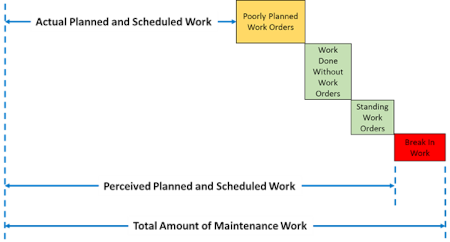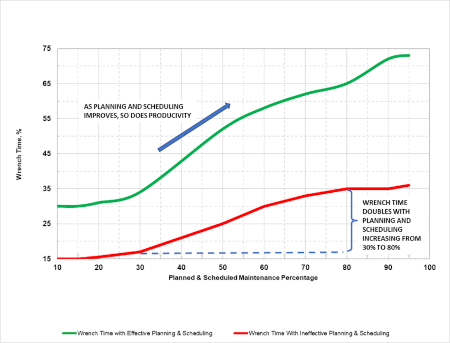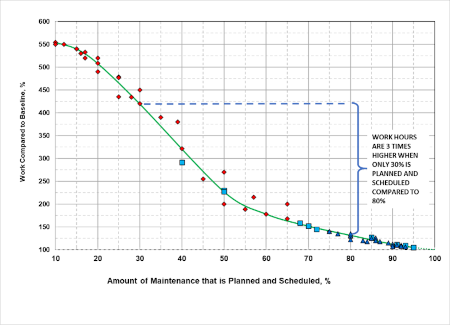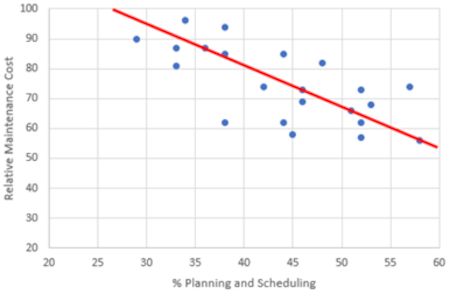Planning and Scheduling May Be the First Place to Improve Field Productivity
Instead of conducting wrench time or time on tool studies, planning and scheduling may be a better place to start when looking to improve field productivity. Wrench time and time on tool studies measure the amount of time that a technician spends on an activity and focus on waste elimination such as extended breaks or transit time. However, they do not measure the work effectiveness and only look at a portion of the maintenance execution process.
So where should you start when you are looking to improve productivity? It depends on where you are with respect to planning and scheduling. Here are some observations about the impact of planning and scheduling:
1. Most people overestimate the amount of planned and scheduled work that is performed at their site.

People often fail to realize that there can be a significant amount of work that is done either on a standing work order or done without a work order. Additionally, work orders that lack definition should not be considered planned. At a site that believes it has high compliance with planning and scheduling, the actual amount of planned and scheduled work can be as much as 20% less than the perception.
2. Planning and scheduling improves wrench time.
 The graph shown here depicts the impact of planning and scheduling on wrench time. The planning and scheduling percentage is shown for two conditions – one for effective planning and scheduling and the other for ineffective planning and scheduling. These curves were determined by comparing planned vs actuals at multiple sites across the globe. When looking at the effective planning and scheduling curve, wrench time increases sharply at the 30% point, flattens a bit at 50%, increases again at 80%, and flattens above 90%. Even with ineffective planning and scheduling, going from 30% to 80% doubles wrench time.
The graph shown here depicts the impact of planning and scheduling on wrench time. The planning and scheduling percentage is shown for two conditions – one for effective planning and scheduling and the other for ineffective planning and scheduling. These curves were determined by comparing planned vs actuals at multiple sites across the globe. When looking at the effective planning and scheduling curve, wrench time increases sharply at the 30% point, flattens a bit at 50%, increases again at 80%, and flattens above 90%. Even with ineffective planning and scheduling, going from 30% to 80% doubles wrench time.
3. The number of work hours needed drops if effective planning and scheduling increases.
 The graph shown here depicts how work hours for the same amount of maintenance activities decrease as planning and scheduling increases. It shows a correlation to the improvement in wrench time, but the improved productivity is also due to improved job plans, correct materials, improved feedback, and the ability to optimize resources. The improved productivity when going from 30% to 80% planning and scheduling more than triples while the wrench time doubles.
The graph shown here depicts how work hours for the same amount of maintenance activities decrease as planning and scheduling increases. It shows a correlation to the improvement in wrench time, but the improved productivity is also due to improved job plans, correct materials, improved feedback, and the ability to optimize resources. The improved productivity when going from 30% to 80% planning and scheduling more than triples while the wrench time doubles.
4. If planning and scheduling increases, costs decrease.

This graph shows the impact of planning and scheduling on maintenance cost. A site that plans and schedules 60% of its maintenance activities has half the cost of a site that plans and schedules 30%.
Becht can help you improve productivity at your site, starting with a couple of questions. The first question to ask is, how much work do we really plan and schedule? If, after considering the amount of work that doesn’t flow through the planning and scheduling process, you are on the upper end of the scale (>80%) then focusing on issues in the field via a wrench time study may make sense. If you aren’t at the upper end, then you should consider how to increase the amount of work that flows through your planning and scheduling process as well as increasing the effectiveness of the planning and scheduling process. To request more information on how to lower your maintenance costs, click the link below:



